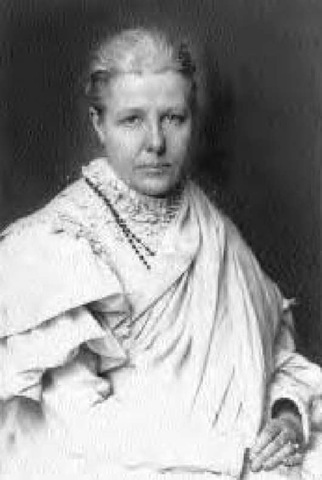Annie Besant, born Annie Wood, was one of the first women, if not the first, to be publicly involved in the public dissemination of information about birth control. Born in London, she was very well educated by her teacher, Ellen Marryat, the sister of a well-known novelist, who wanted her pupils to think for themselves. After flirting briefly with free thought, and totally ignorant of what marriage might mean, Wood drifted into marriage with the Reverend Frank Besant. She was at first frightened and then outraged when her husband pocketed a check for thirty shillings she had earned for a short story. She became further upset when she found out that any money a wife earned belonged, according to the law, to her husband.
In January 1869, Besant gave birth to a son, Arthur Digby. A daughter, Mabel Emily, nineteenth months later was born prematurely as a result of a blow from Frank Besant while Annie was pleading with him to limit the size of their family. Annie Besant still remained faithful to her husband but began to again question his religion, and she wrote an unsigned essay, On the Deity of Jesus of Nazareth (1873). The two quarreled over her changing beliefs, and after once threatening to throw her over a stile, Frank issued an ultimatum that she must resume attendance at Communion or leave home. She left, but found herself penniless.
While briefly serving as a tutor, Besant began writing free thought pamphlets. Charles Brad-laugh, the editor of the National Reformer, offered her a paid position on his newspaper, which she accepted. She also began to give public lectures on various topics. This activity enraged her estranged husband, who challenged the custodianship she had of their daughter. Under the deed of separation, he had retained custody of their son, while she had custody of their daughter until she came of age. In 1878, when Besant was in the midst of a trial involving herself and Bradlaugh over contraception— the famous Bradlaugh-Besant trial—her husband went to court to get the custody of their daughter transferred to him on the grounds that Besant was propagating atheism. She argued her case in person and lost. The judge told her that her character was tainted and that modest women could not be expected to associate with her. The child was torn from her arms and carried away. Eventually the court of appeal granted Besant the right of access, but the child, indoctrinated by the father, was upset by her visits. Besant therefore resolved not to see or write to either of her children until they were old enough to understand and judge for themselves. Eleven years later, both children chose to return to her. She also gave birth to a daughter fathered by Bradlaugh.
Annie Besant was one of the first women to be involved in the public dissemination of information about birth control; her booklet The Law of Population sold more than 175,000 copies in England.
From free thought Besant moved to socialism, became a member of the Fabian Society, edited a literary magazine, and campaigned for women’s rights as well as contraception. Her writings included a booklet on birth control, The Law of Population, most of which was first published in the National Reformer and then issued as a separate pamphlet in November 1877. It went through many reprintings and by the time Besant withdrew it, it had sold more than 175,000 copies in England. Separate editions were published in the United States. Continually seeking answers, in 1889 she believed she had received a vision telling her that the end to her quest was near. Shortly after this she was asked to review The Secret Doctrine by Madame Helen Petrovna Blavatsky (1831—1891) and was converted to Theosophy and joined the Theosophi-cal Society. Besant resigned from most of her secular groups, withdrew The Law of Population, and refused to sell the copyright to others who wanted it. This was unfortunate because Besant had kept up with changes in the technology of contraception. In the 1887 edition of her book she included the soluble pessary (suppository) and the Indian rubber pessary (cervical cap) as well as the sponge. She also recommended soaking the sponge in a solution of quinine (20 grains of quinine to a pint of water) and douching with this solution as well. Unfortunately quinine is not the most effective spermicide, but it was then believed to be.
Besant became deeply involved in the Theo-sophical Society and went to India, where she became an advocate for Indian independence. She had removed herself from the Malthusian League with her new conversion, but she returned to the league later, although she now believed in self-restraint within marriage and the gradual restriction of the sexual relation to the perpetuation of the race. Besant died in India on September 20, 1933, and her body was burnt in a funeral pyre.

